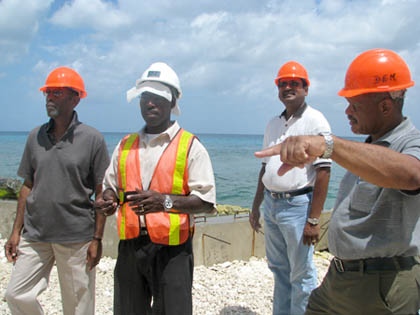EMERGENCY PLANNING TEAMS
Emergency Planning team members should all require the skill to execute processes or functions under less than normal conditions. A planning team must include all the individuals who will take action once the plan has been activated.
Therefore each member must:
- Have their own copy of the emergency plan
- Be familiar with the mission and methodology of the emergency plan
- Participate in the testing of the plan
- Understand their role in the execution of the plan
 It is always recommended that an emergency planning team be composed of persons who have the skill and temperament to make decisions under extraordinary circumstances, and must also be available to place 100% of their concentration on coordinating the activities associated with the plan.
It is always recommended that an emergency planning team be composed of persons who have the skill and temperament to make decisions under extraordinary circumstances, and must also be available to place 100% of their concentration on coordinating the activities associated with the plan.
The process of selecting who should lead this procedure is very important and crucial if any plan is to be effectively and competently executed when an emergency arises.
You therefore must first appoint your commander and his/her team. Managing a disruption requires a commander and team members, who have intimate knowledge of day to day operations and must be knowlegible on the hazards that may impact on the facility. He/she will from time to time have to make quick strategic decisions about their areas of expertise.
Requirements of Emergency Team Members should include:
Members with detailed knowledge of the organisation, vital infrastructure e.g-I.T. operational facilities, management, human resources, employee health and safety and security.
Members with broad knowledge of functional areas e.g customer services, food and beverage procurement, finance, legal and regulatory components.
Members who understand the limits of their authority spending, legalities, finance, management and regulatory arrangements.
Senior leaders may be assigned to assume smooth and time management co-ordination, both in the planning and the execution phases of the plan. These senior management within the planning and execution phases can offer resource strategic inputs and support that will not be there, should these persons not be included in these phases.
Every team needs a leader and an assistant. Each member should understand the hierarchy of the team; their roles and responsibilities. Members roles and responsibilities can change to suit the plan. If a critical member is absent, there should be no doubt about the team’s succession plan.
You can’t anticipate what will happen, when it will happen, how long a disruption may last, or who may be available to take action. Some emergency plans may require long term execution and will disrupt members’ personal lives. Members should recognise this and the team should determine how best to rotate or relieve members, should this be necessary.
Some organisations create back up teams, who often substitute should persons be on vacation or sick leave, when an emergency occurs.
EMERGENCY PLANNING TEAMS
Selection and requirements of the team
Roles and responsibilities of each member
What are you planning for- know the hazards and vulnerabilities
Develop an ongoing preparedness mitigation plan
Prepare preparedness plans
Prepare response plans
Prepare recovery plans
Prepare business continuity concepts
Emergency Management of our Industrial Estates
The time has long past for the management of industrial estates to recognise the benefits of emergency preparedness, to protect staff, visitors and property in their care, in the event of an industrial emergency.
An effective emergency preparedness plan for each location can identify potential hazards and vulnerabilities, so that appropriate steps can be taken to correct those potential problems, before an industrial emergency occurs. Such planning can prevent lost of life and damage to property, and possible resultant financial collapse.
Such planning and analysis will identify:
- Inadequate maintenance or outdated equipment
- Insufficient training
- Storage conditions
- The allocation of type of business to some facilities
- The status of electrical wiring
- Safety procedures
- Poor signage and inadequate fire preventative equipment and safety devices
- Procedures to reduce down time due to utility disruptions and other possible factors identified in the analysis process.
Each location should set up a facility emergency preparedness team, and seek appropriate emergency consultants and knowledgeable person to assist each team to prepare an emergency plan specific for each facility and location.
The team should encourage a wide participation i.e. a representative from each entity to participate in the process. The team must decide a schedule on how the plans will be established and assign roles and responsibilities.
Over the past years, several incidents have impacted a number of our estates. Investigations have concluded that some accidents could have been avoided, or damage reduced if adequate emergency plans and health and safety procedures were established and adhered to.
It is therefore very important to recognise that if such plans are not currently in place, simulated, and periodically updated; we can expect a high probability of loss of life and property and the associated financial losses or possible collapse to some businesses who are housed within these estates.
The first thing after setting up the Emergency Management Team is to assess the current conditions and capabilities of any current preparedness, initiatives or procedures. Next, do a risk analysis I.e. an analysis and determination of probable incidents and their impacts on each facility. This assessment is used to determine safety measures necessary to protect each facility from the incidents.
A complete inventory of equipment, supplies, stores, personnel, a review of the buildings and the use of the buildings, as it relates to the type of business, type of construction, access to buildings and utility services. Conduct a risk analysis of each estate. This assessment will measure the ability of the estate to keep functioning after an emergency incident.
A complete inventory of equipment supplies and personnel and the function of that facility
What communication and warning devices or systems does each business have to communicate internally, inter agency on the estate, and with the local emergency response agencies;-fire, police, medical, utilities.
Can these response agencies adequately access each building with their equipment?
What response capabilities does each business, building or estate have and is it functional and adequate?
When last was it tested or simulated?
What are the evacuation procedures for each business?
How does it relate to the overall evacuation plan for each estate?
Where are the safe escape routes and assembly areas per hazard?
After compiling extensive information about each business and all likely risks indentified, the teams can then proceed to develop a procedural outline to describe what has to be done to mitigate, prepare, respond and recover form any impact to the estate.
Consideration should be made to but is not limited to:-
Flooding, fire, natural disasters, hurricane, structural damage, medical, industrial related accidents, utility disruption, bomb threat, chemical spill, explosions.
The plan should include what steps are necessary to safeguard and retain important company records, and what training is necessary to prepare staff to respond accordingly. For companies which extensively use technology, it is very crucial to have adequate storage of information and off site back up systems.
The plan should include shut down procedures and associated safeguards and re start procedures, should it be necessary to suspend operations due to any reason on the estate.
The plan should critically assess the health and safety requirements and obligations, to ensure all staff and visitors who occupy the estates are safe.
This plan should require each business to declare what hazardous chemicals and substances they are using, and their medical safety data sheets (MSDS) should always be easily accessible for emergency response personnel. These chemicals and substances should be adequately and safely stored in appropriate receptacles, and ventilated spaces, easily accessible if they have to be moved off site in case of an emergency.
The plan must ensure staff are adequately trained and certified where necessary to use various equipment, chemicals and substances. The use of personal protection equipment (PPE) at all times should be a mandatory requirement of each business.
The plan must make provision for a medical facility or access, where all personnel can have access to basic primary treatment, care and assessment, prior to transferring to other emergency personnel if necessary.
After you have developed your plan, with input from all businesses in the estate and which comprehensively identified all risk, the plans should be adopted as a commitment from each unit to collectively cooperate to ensure it is annually tested, staff training and equipment reconfigurations, and communications systems are all in place. Only when the above is comprehensively accomplished, will this team be able to effectively respond to addressing any incident that will occur within the industrial estate. Health and safety procedures will now become part of the daily routine, and scheduled simulations will help to identify any gaps, so that they can be corrected.
Such measures, were they in place, prior to the several incidents experienced over this past 5-10 years, would have significantly reduced the number of incidents and also reduce the financial and employment losses experienced.
